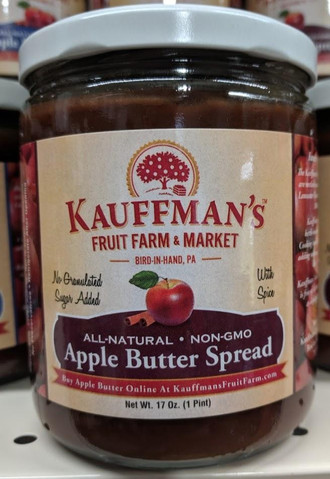Posted by Jeff Pauls on 24th Apr 2019
How Long is Apple Butter Good For and Other Pressing Questions
At Kauffman’s Fruit Farm & Market, we strive every day to provide you with a quality product and friendly service.
Many people enjoy coming back again and again to our market. I know people who have moved away, but try to get to our market as often as they can because their childhood memories are so good from when their parents brought them along shopping. What really sticks in their mind are the yummy snacks of homemade bread slathered with our premium Apple Butter. Or, on a cool winter’s night, their tummies warmed by our hot cider. And then there were those hot Autumn days when it feels like summer again. What was better than going to the refrigerator and pouring yourself a tall, cold glass easily mistaken for an actual apple, but when taking a second look, there it was, our delicious apple cider.
Speaking of the refrigerator, did you ever wonder about the labels on food? Stuff seems like it’s still ok, but the date seems to say otherwise. Just how long can you use products that you’ve purchased for your family to eat? We’ve recently been discussing this concept at Kauffman’s, and while we don’t want anyone to use anything that might be spoiled, why throw away perfectly good food? That’s when our wholesale manager, Ryan Hipps, came across the article below. It says it so well that we’re just running it verbatim. Check it out, it’s quite interesting...
Confused by “best by,” “sell by,” and “use by”? You’re not alone. In fact, a Harvard University study found that more than 90 percent of Americans throw away perfectly good food due to label confusion—resulting in 398,000 tons of food waste each year. Because, as it turns out, those eggs with a sell-by date don’t suddenly turn rotten at midnight.
Understand what those labels really mean. “Sell by,” “use by,” and “best by” are actually all dates determined by the food manufacturers, and they’re the manufacturers’ best guess as to food quality—not food safety. Basically, they indicate how long a food producer will guarantee their product will still be at peak quality to enjoy.
And there’s no governmental authority policing how those dates are used—though Congress has tried (and failed) to pass legislation in recent years to try to standardize this labeling and clear up the confusion. Depending on the product and how it’s been handled, it is likely perfectly safe to eat for days or weeks after that sell-by, use-by or best-by date has passed. Check out which foods you might be throwing away too soon.
Ignore the sell-by date. According to the Natural Resources Defense Council, “the sell-by date is literally just for the stores themselves,” so the manufacturer can let them know when a product may be past its prime and need to be taken off of store shelves. (Again, it may still be perfectly tasty and perfectly safe for long past that date.)
Inspect your food. You can usually tell quickly when a product’s gone bad—there’s mold on the bread, or the milk smells sour. “Check the quality of the specific product by smell, taste, if it’s visually okay, if there’s no mold or discoloration,” says Stacey Antine, MS, RDN, founder of HealthBarn USA. Keep in mind that bad things can “happen even before the use-by or sell-by date,” especially if it’s a perishable food that may have spent time at an unsafe temperature. See which foods you should definitely toss by the expiration date.
Stop the clock. Have food that you know you won’t finish before it might go bad? Just chill. “If you are getting close to the indicated date…put it in the freezer,” Antine suggests. “It sustains the product, extends its life, and reduces food waste.” Next, read on for 50 more secrets food manufacturers won’t tell you.
Originally Published on Reader's Digest

